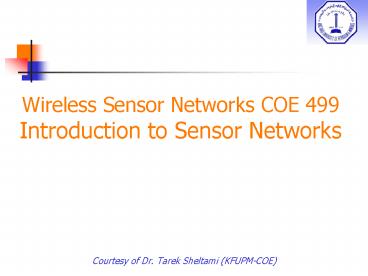Wireless Sensor Networks COE 499 Introduction to Sensor Networks - PowerPoint PPT Presentation
1 / 40
Title:
Wireless Sensor Networks COE 499 Introduction to Sensor Networks
Description:
Custom built at UC, Berkeley for wireless sensor nodes ... Capsule Endoscope. Finger Tip Sensors. JPL Sensor. A Bee Tracker. 10. 10. 10. 10. 10. 10. 10 ... – PowerPoint PPT presentation
Number of Views:358
Avg rating:3.0/5.0
Title: Wireless Sensor Networks COE 499 Introduction to Sensor Networks
1
Wireless Sensor Networks COE 499Introduction to
Sensor Networks
- Courtesy of Dr. Tarek Sheltami (KFUPM-COE)
2
Outline
- Introduction
- Application Areas
- Systems Involved
- Communications
- Challenges in SNETs
- Unique constraints
- Power Issues
3
Involved Technologies
Network Technology
Sensor Network
Computational Power
Sensor Technology
4
Application Areas
- Military
- Infrastructure security
- Environment Habitat Monitoring
- Healthcare
- Industrial Sensing
- Traffic Control
- Seismic Studies
- Life Sciences
5
The Systems involved
- Sensor Node Internals
- Operating System
- Physical Size
6
Sensor Node Internals
CPU
INFRARED ACOUSTIC SEISMIC IMAGE MAGNETIC
POWER SUPPLY
ELECTRO-MAGNETIC INTERFACE
SENSOR
COMMUNICATION
NODE
- Some Current Node Platforms
- Sensoria WINS
- Smart Dust Dust Inc. Berkeley
- UC Berkeley mote Crossbow (www.xbow.com)
7
Operating System - TinyOS
- Custom built at UC, Berkeley for wireless sensor
nodes - Component-based architecture ensures minimum
code size - Component library includes
- Network protocols
- Sensor drivers
- Data acquisition tools
- Distributed services
8
Physical Size
WINS NG 2.0
Berkley Motes
AWAIRS I
LWIM III
AWACS
9
A Few Smart Sensor Implementations
Finger Tip Sensors
Smart Its Project
Tiny Heart
Capsule Endoscope
JPL Sensor
A Bee Tracker
10
Smart Sensor Example in Health Care
- Can be taken just like a capsule
- It moves through the intestinal track due to
contraction and relaxation - Excreted naturally and is disposed off
- Safe to the body
- Future Remote control Pills and Micro-surgery
Duodenal Bleeding
11
BioMimetics
- Living organisms use sensory abilities for all
activities - This is in spite of lot of noise in the
environment - The science of such sensory fusion is available
in Biology - BioMimetics Mimic the available knowledge in
Biology to design robust sensor fusion algorithms - A few preliminary applications are shown below
Electronic Tongue
Electronic Nose
12
Sensor Network in Health Care Contd
- In-Home Health Care Solution from Intel
- In-home technology prototypes illustrate how tiny
silicon-based sensing devices discreetly embedded
in objects such as shoes, furniture and home
appliances - It can make it possible for elders, Alzheimer's
disease patients and others with disabling
conditions to continue to live at home - Intel and university researchers determined that
wireless sensor networks, combined with powerful
computing and complex algorithms, can effectively
send prompts through various household devices to
assist the elderly and inform, as well as ease
the workload of caregivers.
13
In-Home Health Care Solution from Intel
- Intel Research Seattle uses postage-sized
wireless radio frequency identification (RFID)
tags affixed to household objects - To monitor and record the daily activities of an
elder - The tags wirelessly communicate the data back to
a central system that could help manage everyday
activities so that the elders' independence is
maintained while relieving some of the burden of
around-the-clock care by caregivers
14
California Institute of Technology - MicroBat
15
Solar panel.
Cabinet with radio sender, micro processor and
digital and analog I/O.
Water level sensor.
Water wheel at farm gate.
16
Central Goulburn no. 2 channel.
17
Mulwala canal. Largest irrigation channel in the
southern hemisphere.
18
Communication
- Network Protocol
- Network Discovery
- Network Control Routing
19
Network Protocol
- For wireless sensor networks IEEE 802.11
standards - Personal Area Networks (PAN) IEEE 802.15
standard - Radius of 5 to 10m
- Ideal application in short-range sensors
20
Network Discovery
- Knowledge of identity and location of its
neighbor - Ad hoc protocols can be used
- GPS system can be used as well
21
Network Control Routing
- Network adapts dynamically to
- conserve resources like energy and available
nodes - Make optimum use of bandwidth and processing
power - Connectivity must emerge as needed from
algorithms - Directed Diffusion routing
- Data identity is separate from node identity
- Promotes adaptive, in-network processing
22
Sensors
- Passive elements seismic, acoustic, infrared,
strain, humidity, temperature, etc. - Passive Arrays imagers (visible, IR),
biochemical - Active sensors radar, sonar
- High energy, in contrast to passive elements
- Technology trend use of IC technology for
increased robustness, lower cost, smaller size
23
Sensor Network Challenges
- Low computational power
- Current mote processors run at lt 10 MIPS (Million
Instructions Per Second) - Not enough horsepower to do real signal
processing - Memory not enough to store significant data
- Poor communication bandwidth, current radios
achieve about 10 Kbps per mote - Note that raw channel capacity is much greater
Overhead due to CSMA backoff, noise floor
detection, start symbol, etc. - 802.15.4 (Zigbee) radios now available at 250
Kbps - But with small packets one node can only transmit
around 25 kbps
24
Sensor Network Challenges..
- Limited energy budget
- 2 AA motes provide about 2850 mAh
- Coin-cell Li-Ion batteries provide around 800 mAh
- Solar cells can generate around 5 mA/cm2 in
direct sunlight - Must use low duty cycle operation to extend
lifetime beyond a few days
25
Sensor Network Challenges..
- Portable, energy-efficient devices
- End-to-end quality of service
- Seamless operation under context changes
- Context-aware operation
- Secure operation
- Sophisticated services for simple clients
26
Sensor Network Challenges - Summary
- Extended lifetime
- Responsiveness
- Robustness
- Synergy
- Scalability
- Heterogeneity
- Self-configuration
- Self-optimization Adaptation
- Systematic design
- Privacy Security
27
Unique Aspects
- Number of sensor nodes can be many orders of
magnitude larger than number of nodes in an ad
hoc network - Tens of thousands.
- But individual ID might not be needed.
- Sensors might be very small, cheap, and prone to
failure. - Therefore, we need redundancy.
- Extremely limited in power, and must stay
operative for long time - Energy harvesting might be considered.
- Sensors might be densely deployed.
- Opportunity for using redundancy to improve the
robustness of the system
28
Unique Aspects..
- Very limited mobility
- Helps with the design of the protocols
- Measurements might be correlated.
- Example measurements of temperature, pressure,
humidity, etc. - Volume of transmitted data might be greatly
reduced. - For many applications, nodes are randomly
deployed. - Thrown by a plane, carried by wind, etc.
29
Location-dependent Information
- Changing context
- small movements may cause large changes
- caching may become ineffective
- dynamic transfer to nearest server for a service
30
Portability
- Power is key
- long mean-time-to-recharge, small weight, volume
- Risk to data due to easier privacy breach
- network integrated terminals with no local
storage - Small user interfaces
- small displays, analog inputs (speech,
handwriting) instead of buttons and keyboards - Small storage capacity
- data compression, network storage, compressed
virtual memory, compact scripts vs. compiled code
31
Low Power Energy-awareness
- Battery technology is a hurdle
- Typical laptop 30 display, 30 CPU, 30 rest
- wireless communication and multimedia processing
incur significant power overhead - Low power
- circuits, architectures, protocols
- Power management
- Right power at the right place at the right time
- Battery model
32
Low Power Energy-awareness..
- There are many means for powering nodes, although
the reality is that various electrical sources
are by far the most convenient. - Technology trends indicate that within the
lifetime of Embedded Networked Sensors (ENS),
nodes will likely be available that could live
off ambient light. - However, this cannot be accomplished without
aggressive energy management at many levels
continuous communications alone would exceed the
typical energy budgets.
33
Sensor Node Energy Roadmap
Source ISI DARPA PAC/C Program
10,000 1,000 100 10 1 .1
Rehosting to Low Power COTS (10x)
- Deployed (5W)
- PAC/C Baseline (.5W)
Average Power (mW)
- (50 mW)
-System-On-Chip -Adv Power Management Algorithms
(50x)
- (1mW)
2002 2004 2000
34
Battery Technology
- Battery technology has historically improved at a
very slow pace - NiCd improved by x2 over 30 years!
- require breakthroughs in chemistry
35
Comparison of Energy Sources
Source UC Berkeley
With aggressive energy management, ENS might live
off the environment
36
Computation Communication
Energy breakdown for MPEG
Energy breakdown for voice
Decode
Transmit
Decode
Encode
Encode
Receive
Receive
Transmit
Radio Lucent WaveLAN at 2 Mbps
Processor StrongARM SA-1100 at 150 MIPS
- Radios benefit less from technology improvements
than processors - The relative impact of the communication
subsystem on the system energy consumption will
grow
37
Key Issue Resource Awareness
Inherent unpredictability
Solution adaptation
Resource awareness
right resource at the right time and the right
place
- Wireless Backbone Networks
- High traffic load
- Limited available spectrum
- Focus on transmission resources
- Wireless Ad-Hoc Networks
- Unattended operation
- Limited available battery
- Focus on energy resources
38
Event Driven Model
39
On-Demand Model
40
TinyOS is an open-source operating system
designed for wireless embedded sensor networks.
It features a component-based architecture which
enables rapid innovation and implementation while
minimizing code size as required by the severe
memory constraints inherent in sensor networks.
TinyOS's component library includes network
protocols, distributed services, sensor drivers,
and data acquisition tools all of which can be
used as-is or be further refined for a custom
application. TinyOS's event-driven execution
model enables fine-grained power management yet
allows the scheduling flexibility made necessary
by the unpredictable nature of wireless
communication and physical world interfaces.
TinyOS has been ported to over a dozen platforms
and numerous sensor boards. A wide community uses
it in simulation to develop and test various
algorithms and protocols. New releases see over
10,000 downloads. Over 500 research groups and
companies are using TinyOS on the
Berkeley/Crossbow Motes. Numerous groups are
actively contributing code to the sourceforge
site and working together to establish standard,
interoperable network services built from a base
of direct experience and honed through
competitive analysis in an open environment.































